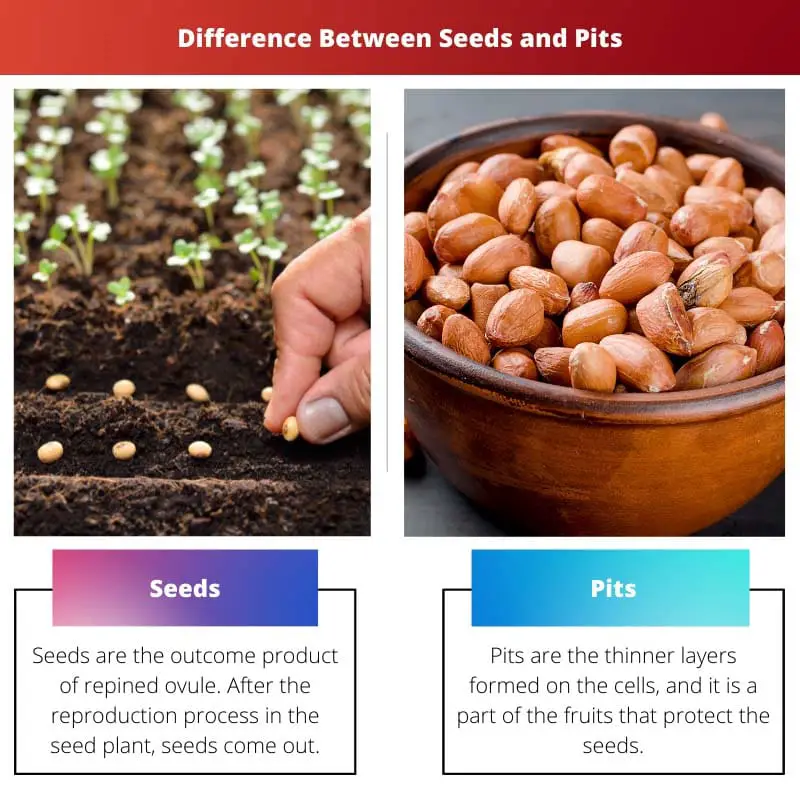The seed is a part of the seed plant. Pits are the thinner layers formed on the cells, and it is a part of the fruits that protect the seeds.
Key Takeaways
- Seeds are enclosed in fruit and can reproduce, while pits are hard, shell-like coverings of the seed found in fruits like peaches and plums.
- Seeds are the primary source of a plant’s reproduction, while pits are mostly used for the plant’s protection.
- Seeds are found in fleshy fruits like apples and oranges, while pits are in drupes like cherries and apricots.
Seeds vs Pits
Pits are just a part of fruits that protects the seed up to the growth period. Seeds are ovules containing embryos. In seed plants, seed formation is a part of the reproduction process.

Seeds are the outcome product of repined ovule. From the integuments of the ovule, the seed coat and embryo had developed, and the fertilization by pollen and growth of the mother plant took place.
Pits are the primary cell walls or membranes between the adjacent cells, characteristic of cell walls containing the secondary layer. Pits are the typical feature of the xylem, where liquid flows through the pits of the xylem cells.
Comparison Table
| Parameters of Comparison | Seeds | Pits |
|---|---|---|
| Meaning | Seeds are the outcome product of repined ovule. After the reproduction process in the seed plant, seeds come out. | Pits are the thinner layers formed on the cells, and it is a part of the fruits that protect the seeds. |
| Consist in | Seeds are related to plants and food. | Pits can connect to the human body, Botany, Science and technology, plants and food. |
| Introduced | Three hundred sixty million years ago, the seeds had introduced. Elksinia polymorpha was the first plant that used sources. | One billion years ago, scientists found pits and their importance in plants. |
| Types | There are four types of seeds. Dicotyledonous Exalbuminous Seeds. Dicotyledonous Albuminous seeds. Monocotyledonous Exalbuminous seeds. Monocotyledonous Albuminous seeds. | Pits are of two types. 1. Simple pits. 2. Bordered pits. |
| Having | Seeds are rich in proteins, minerals, healthy fats, fibre, and Vitamins like B1, B2, B3 and Vitamin E. | Pits like cherries, apricots, and peaches have a compound called Amygdalin. When ingested, it is a dangerous compound that breaks down into hydrogen cyanide. |
What are Seeds?
A seed is part of a seed plant. Seeds undergo the reproduction process in the seed plant.
Seeds occupy high fibre sources, which helps control and reduce blood pressure, blood sugar and cholesterol. Several seeds can help with different types of health problems. Serving 200 calories of grains per day helps in maintaining good health.

What are Pits?
The word pit has different types meanings. Pits are not only present in plants and food items but also present in the human body.
There are two types of Pits, Simple Pits and the other had Bordered Pits. An individual cannot eat Pit alone, which is poisonous to the body. Sometimes Pits are used for planting.

Main Differences Between Seeds and Pits
- A seed is part of a seed plant, where a new plant development occurs. In contrast, Pits are just a part of the fruit that protects the roots.
- Seeds are available in plants and food products, where we can observe Pits in the human body, plants, and food products.
- Seeds can eat by humans, but Pits are dangerous to eat.




